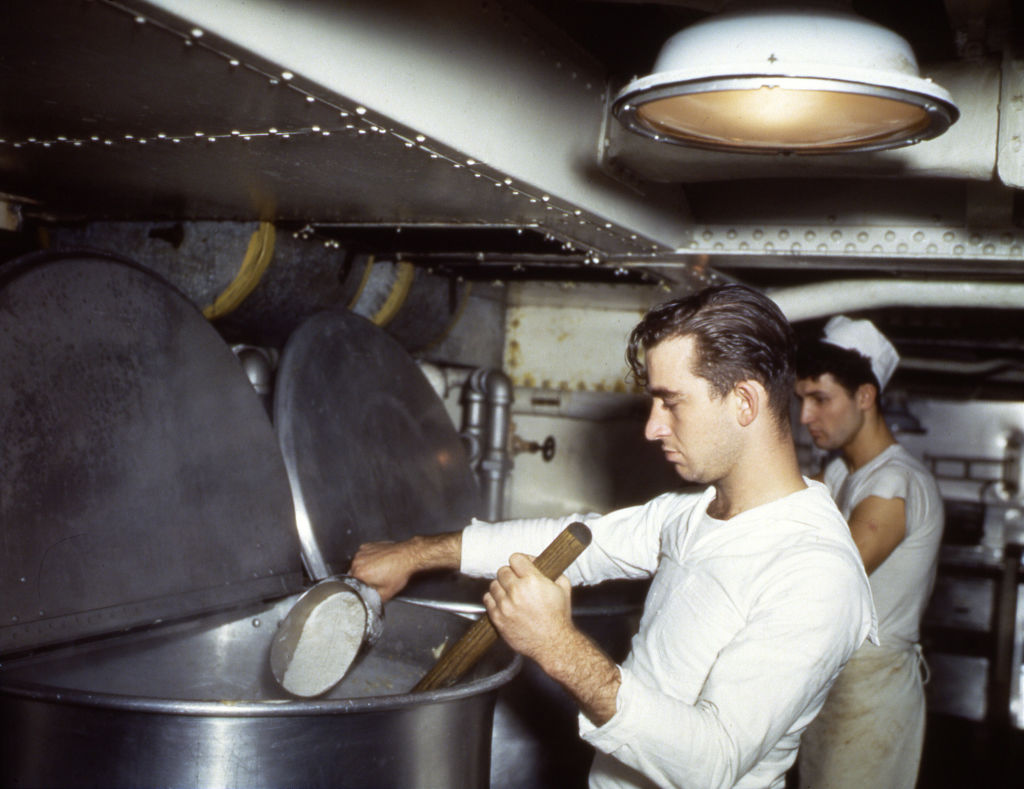

There’s an old saying that “an army marches on its stomach.” It could be said that a navy sails on its stomach. And during World War II the United States Navy wanted to make sure its cooks knew how to feed thousands of sailors.
“The Cook Book of the United States Navy,” published in July 1945, is a look inside the logistics and planning that went into keeping sailors fed in the Pacific and European theaters of war. The cookbook dives into menu planning, the basics of cooking and benefits of different types of food. Everything from portion size to how to properly make ice cream was considered.
“Many of the recipes were suggested and tested by commissary personnel of the Navy, and all the recipes have been developed and tested for practical use in the Navy,” W. J. Carter, the Navy’s Chief of the Bureau of Supplies and Accounts, wrote in the forward.
Although the days of World War II might not bring to mind a strong focus on nutrition, the Navy’s cookbook is primarily focused on it. It talks about making sure sailors receive between 3,000-4,500 calories per day. That’s partly due to the high level of activity they were conducting and also because going into World War II many Americans were underweight and malnourished due to the Great Depression.
Recipes range from familiar items to some more early-mid 20th Century favorites. There are recipes for both hot and cold potato salad, knickerbocker bean soup and how to make scrambled eggs both with fresh and dehydrated eggs. In fact, a number of recipes focus on using dehydrated and reconstituted food products, a requirement for transporting some food goods on extended tours.
The cookbook is primarily a field manual of sorts, direct and full of instructions. Portions of the book point out the pros and cons of different ways of cooking meat, from baking to broiling. But it offers some amusing insight to the Navy’s appreciation for food, and its favorites. Cheese, for instance, “takes exceedingly high rank on the list of essential foods in the Navy.” Other details suggest how to pair items in a meal; serve lighter desserts after a heavy meal and vice versa. Several pages are devoted to coffee, from the storage to preparation of it.
“Navy coffee has been expertly blended and roasted,” the book says. “If a few simple rules for making coffee are followed, a rich and enjoyable brew may be expected.”
The island hopping campaign in the Pacific was a brutal and bloody slog. Living off of meager rations in the field could be rough. For sailors on a ship or any other troops being transported by the Navy, a fresh cooked meal could be a major morale boost. That said, the book is mostly light on the kind of color or descriptions one might find in other cookbooks; it’s more about basic cooking techniques and scaling for the amount of mouths to feed than flavor. The Navy did consider it though. A note on seasonings says that they “have an important place in the Navy diet as they help to relieve monotony and make the food more palatable and interesting.”
Desserts and other sweets also make up a large number of chapters in the cookbook. Ice cream, it notes, should be a “regular” on the menu, in part because it is “nourishing and economical.” That was the Navy’s official stance in 1945.
Subscribe to Task & Purpose Today. Get the latest military news and culture in your inbox daily.
It’s also worth noting the date it was published. The book came out in July 1945, and was in the works before that. Yes, World War II was going well for the Allies, with Germany’s surrender marking victory in Europe, but the war in the Pacific remained a brutal and bloody campaign. The Battle of Okinawa, one of the most intense land battles against the Japanese armed forces, was raging while the book was being written. This is a cookbook for a wartime U.S. Navy. Carter notes that this edition has a greater emphasis on dry goods in “an attempt to assist with some of the feeding problems of the forces afloat and at advance bases.”
Despite that, the cookbook is devoid of references to war. Any order of battle is about the proper steps to prepare, plan and execute feeding a large number of sailors.
So, nine decades later, how does the Navy’s wartime cookbook sound?
The latest on Task & Purpose
- Hawaii soldier earns rare triple tab: Ranger, Sapper, Jungle
- ‘I want to be an infantryman,’ says man who joined the Army at 39
- New Tinker Air Force Base motto immediately lampooned by airmen, veterans
- Army Chinook takes flight with ‘FUKIRAN’ call sign
- Navy fires captain of USS John S. McCain for “loss of confidence”
